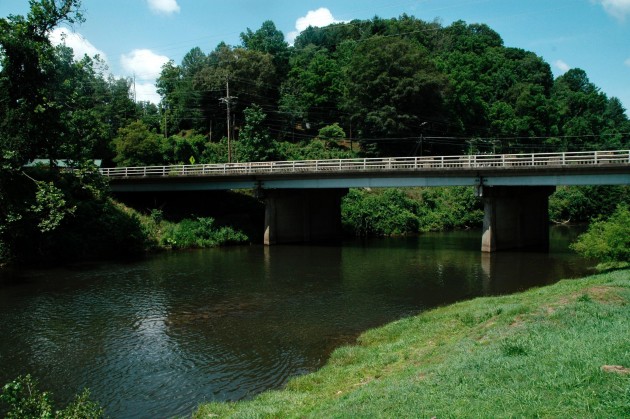
The North Carolina Department of Transportation (NCDOT) office in the 14th division of North Carolina decided to go ahead with a plan known as “Alternate 1” for the future renovation of a bridge on Old Cullowhee Road near Western Carolina University’s campus.
“Alternate 1” involves rebuilding Old Cullowhee Bridge where it stands, one-half at a time. The half of the bridge not under construction will remain open to allow traffic to flow, albeit in a constricted manner.
The bridge, located near Wayehutta Road and Cullowhee Auto Service, serves as an important artery for cars heading in and out of the Cullowhee area. During the bridge’s construction, which is projected to cost approximately $6,766,000, motorists can expect a five to seven minute delay when waiting for their turn to cross the bridge. Workers will be in the water, which is a threat to a local endangered species of mussel, the Appalachian elktoe.
Joel Setzer, division engineer for the 14th division, said that the NCDOT reached its decision unanimously and that, in instances like this, the DOT employs the use of tri-managers to reach a decision.
“It’s a committee decision on a project like this. In this particular situation the three managers all agreed that Alternate 1 was the best plan of action,” said Setzer.
This conclusion was reached, according to Setzer, because Alternate 1 was the best option for the most people.
“It was the best. It cost less, it’s what the most people wanted, and there wasn’t any appreciable difference in the effect on the environment with this alternate,” said Setzer.
Alternate 2, the other potential plan, would have cost nearly $1 million dollars more than Alternate 1 and would have required additional businesses to sell their property to the state and relocate.
The plan called for construction of the new bridge in an entirely new location, which would have required the demolition of four buildings including the one housing Cullowhee Auto Service. While it would have caused less inconvenience for motorists, the effect on businesses and the local environment was too much to gain any real support.
Cullowhee Auto Service owner Chris Pressley said he is glad NCDOT made the right decision.
Pressley and his family have operated their business in the Cullowhee area for 65 years, going back to his grandfather who started the business.
“I feel pretty good. I’m glad we’re going to get to keep our building,” said Pressley.
Pressley, who has two daughters, added that he appreciates the public’s support and all those who contacted the NCDOT to show that the community wanted Alternate 1.
Although some community members did support Alternate 2, the vast majority came to the defense of Pressley and business owners like him who did not want to have to sell or relocate their buildings.
Even though Alternate 1 saves the most buildings from possible acquisition and demolition, a number of buildings will still need to be acquired for the project regardless of which alternate was chosen.
Pressley said he knew of “4 or 5 buildings” that will be acquired by the State and required to sell and relocate. The Cullowhee Real Estate office and the old Speedy’s building are among the few.
Both the NCDOT and independent appraisers will compensate owners for the buildings and the lots according to market value as determined. All affected owners have the right to reject the offer from the government and appeal to have the matter settled by a jury of their peers.
The bridge itself was built “sometime during the 1940s,” according to Setzer. In its present condition, the Old Cullowhee Road Bridge meets the definitions of the engineering terms “structurally deficient” and “functionally obsolete.”
According to the Federal Highway Administration, “structurally deficient” means that the deck, superstructure, substructure or culvert of the bridge is rated in “poor” condition or its load carrying capacity is significantly below current design standards. “Functionally obsolete” simply means that the design of the structure is outdated.
These terms mean that while the bridge is not currently a danger to motorists, it has the possibility of becoming so if it is not replaced in the coming years.
WCU students largely agreed with the decision made by NCDOT.
Ryan Prather, sophomore and a major in choral education, said he uses the bridge often and likes Alternate 1.
“So long as they do it differently than some of the other bridge reconstructions, I’ll be happy,” said Prather.
Tanner Morris, a sophomore studying communication and broadcasting, explained that he does not recall ever using the bridge, so he is unsure if it will affect him.
“I feel like going with the cheaper and more environmentally friendly alternative is probably the better choice,” said Morris.
Brian Burch, division construction engineer, said that the project start date is set for January 2015.






